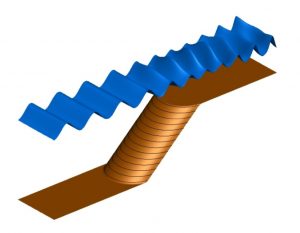CFD platforms
AeroSol: a parallel finite element library
SLOWS: finite volume/element and residual distribution shallow water solver
- SH-COMP(Self Healing Composites): Fortran 90 code for the simulation of the oxidation process in self-healing composites. SH-COMP solves a set of PDEs and ODES relative to the oxidation (chemistry) and oxide flow (potential) model within a transversal crack using a finite element discretisation. Under substantial re-writing within the ANR VISCAP. More information coming soon
Meshing libraries: MMG tools
The MMG tools gather applications for surface and volume remeshing. They include 3 main modules:
- Mmg platform: meshing/remeshing platform constituted by mmgs (adaptation and optimization of a surface three-dimensional triangulation representing a piecewise linear approximation of an underlying surface geometry), mmg2d and mmg3d (triangular and tetrahedral fully automatic remeshers. Starting from a tetrahedral mesh, it produces quasi-uniform grids optimized with respect to a metric tensor field).Discover the Mmg platform.The sources of the MMG platform are available on GitHub. You can download precompiled binaries here. Check out also the MMG tutorials (see banner below);
- ParMMG: library for parallel (MPI) simplicial 3D remeshing. Included in the MMG tools;
- nomesh: a software allowing the generation of third order curved simplicial meshes. Starting from a “classical” mesh with straight elements composed by triangles and/or tetrahedra, we are able to curve the boundary mesh. Starting from a mesh with some curved elements, we can verify if the mesh is valid, that means there is no crossing elements and only positive Jacobian. If the curved mesh is non valid, we modify itusing linear elasticity equations until having a valid curved mesh;
- fmg: is an r-adaptation library deforming an input/reference simplicial mesh w.r.t. a given smoothness error monitor (function gradient or Hessian), metric field, or given mesh size distribution. Displacements are computed by solving an elliptic equation for the displacements with a continuous finite element method. The library returns an adapted mesh with a corresponding projected solution, obtained by either a second order projection, or by an ALE finite element remap.


